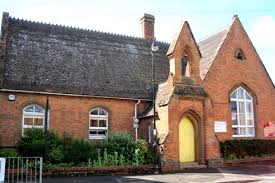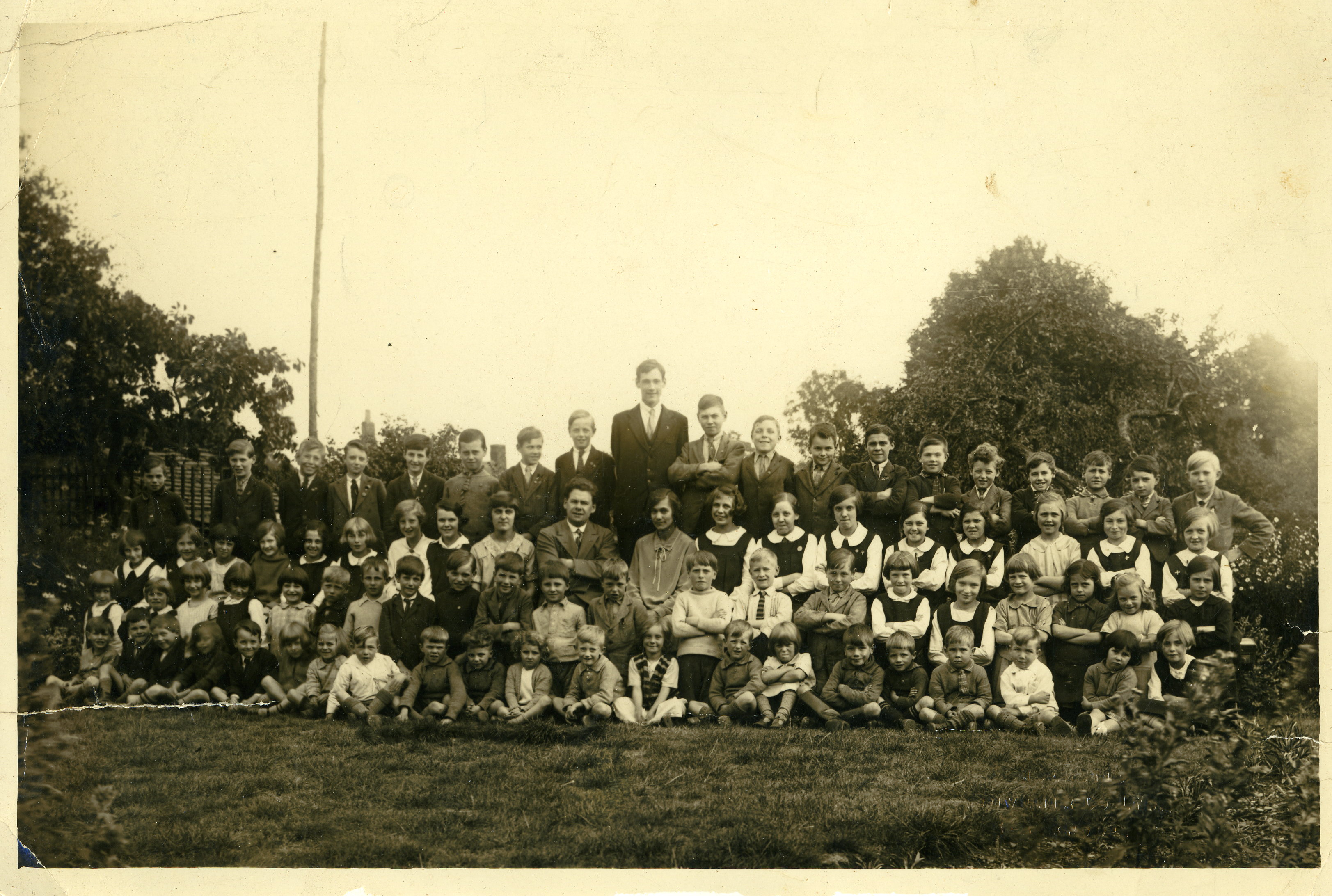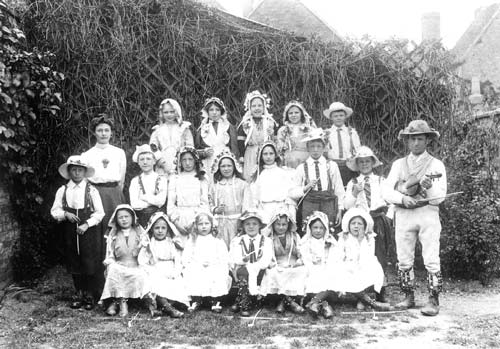The one thing that hasn’t changed is the presence of a school in Barford since 1677 when Thomas Dugard left money in his will for the teaching of children to read and reckon and ‘poor girls’ to sew.
In 1787 the present school house was obtained on a lease and in 1819 was bought by the Rev. Francis Mills for the exclusive use of the schoolmaster.
‘The school is kept in the schoolhouse and consists of 30 boys and 30 girls. They are instructed in reading, writing and arithmetic; the girls are taught to sew by the master’s wife’
Clearly, sewing for girls, was of prime importance.

In 1851 the present school was erected by the National Society. This early school consisted of two large rooms, boys and girls being segregated. Later when infants were admitted they attended a separate class in the Malt Barn.
The school log books are a rich fund of information and many of the entries help fill in gaps in our knowledge of social history.
Extracts from the School logbooks, 1924 —1938
From 1870, all grant aided schools had to keep a school logbook. The head had to write a report in it at least once a week, and the report had to include information about attendance, illnesses and any noteworthy events. They were read by the Inspector on every School Inspection. Barford school logbooks are now held at the County Record office.
In 1925 the school received its HMI (His Majesty’s Inspectorate) report from a Mr. Bright
‘The children seem quite incapable of taking responsibility for their own work’
Schemes of work are incomplete, ill chosen, and some are worthless’
‘Supervision of lower classes should be more thorough’
‘The practice of taking all the 4 standards of the Senior Section together for such lessons as History and Geography should be discontinued.’
‘None of the girls have learnt how to use a sewing machine at school and there have been no systematic mending lessons’
Some things in education never change but other things, mercifully, have!
In 1924
the cleaner was paid £1 6s 0d Per Quarter
the Caretaker £2 11s 0d
And the fire lighter 1/- daily
This for a school of 113 mixed age pupils and 66 infants.
Equipment seemed to be a constant source of worry.
In1926 there were no arithmetic text books apart from a half a dozen for standard VI and in 1927 when Frank Miller Smith became Head he wrote

Barford School 1929
’In the necessary stock for a progressive school, there is a serious lacking. Excess in a few things, chalk, play wax and paint’
Warwick was approached and new furniture stock and sewing machines were requested.
In fact Mr. Miller Smith was a bit of a ‘new broom’. He instigated schemes of work after having a staff meeting. New subjects were discussed such as art, science, handwork, games, practical maths and hygiene..
After a staff meeting it was decided to have a house system –the Reds, Whites and Blues and in May there was a census of the Upper School with a view to forming a leaver’s class.
Health was of much importance in the early years of the 20th century. The issues ranged from headlice to epidemics.
In May 1927 the school nurse inspected heads and
‘One case of a minor type was found and the child not expelled’.
In June out of 32 children inspected by the school dentist — 23 required treatment.
Whooping cough epidemics were relatively common and the attendance officer was often called in to make a decision as to whether the school should remain open or not.
Measles was an equally potential killer. In May 1932 36 pupils had contracted the infection and the school was closed.
In March 1937 mumps went on until the end of May and in June of that year Whooping cough started and the school was closed on July 19th by the District Medical Officer by telegram.
In 1937 there were two notifications of diphtheria. The children’s books were destroyed. Within 3 days the school was closed. Over the Christmas holidays the school had to be disinfected by the local sanitary authority and more books destroyed. The school reopened on 10th January with 6 fresh cases of chicken pox ! No wonder the school nurse visited so regularly and became known as the ‘health visitor’
Children with any kind of problem in the early 19th century were often classed as ‘defective’.
In 1926 the school was inspected by the school Medical Officer’. Very few defective children found’. This was the time when back straighteners were still worn!
The causes of disease were also taken very seriously .In 1937 The Rural District Sanitary Inspector inspected the defective drains and condemned the whole system in the boy’s playground.
Real attempts were made to improve the children’s health. In May 1932 milk was introduced.
‘An experiment made with providing of milk for scholars. 2 bottles given away. Continued the experiment. 5 bottles (1 pint) were distributed and paid for. Today another 5 bottles. Child is to bring 3d and receive ¼ pint per day.’
Seven bottles were distributed 2 days later and finally one gallon.
In 1936 the County milk scheme started. It seems that Barford School was before it’s time.
During the 20’s and 30’s there was a greater emphasis on fitness.
In 1926 the log book says, Physical Exercises cannot be performed due to very restricted space’. But in May 1927 PT and games were started. In December there is mention of a football match versus Central School Stratford and in March 1928 netball posts, stool ball posts and bats arrived’. Things continued to improve and in March 1931 the County PE Organiser of Physical training, visited the school and saw PT taken by staff. He expressed ‘ approval and pleasure’
In 1937 after a report by HMI that there was no gardening in March of this year the log book reports:
‘Mr. Rutland and the County Horticultural advisor visited, who, together with the Rector and Headmaster, inspected two plots of ground. One an allotment and the other a portion of the rectory garden, with a view of commencing school gardening’
This was obviously acted upon as in September a Mr Craig visited
‘requiring particulars of numbers of children who would be taking school gardening’ and on 4th October the first gardening lesson was held —spent in preliminary cleaning!
Subsequent reports mention 150 eggs being collected and sent to Warneford Hospital Leamington Spa and a
‘ Mr G. Nash, Horticultural Advisor viewed the school gardens and expressed satisfaction with the start made. He afterwards addressed the senior children concerning potato leaf curl and flower habits and construction’
The seasons seemed to play a large part in the life of the school particularly the winter months.
January 1931
‘School closed – lack of fuel – temperature 45 degrees [Fahrenheit, 7 degrees Celcius]
‘School lunch 12.00- 1.30pm. Children out of district then able to get home before dark’ (most children had to walk to school in those days)
‘With the help of Nurse Randall the dinner children will be served cocoa during the dinner hour’
January 1937
‘Heating apparatus out of action. Seniors and Infants rooms were cold in spite of large fires ‘
‘Horlicks served again’
As nowadays, weather affected School life.
In May 1932 the log reports attendances dropping. ‘Heavy rains and floods have kept many children away.’No change there then.
Poverty in the early part of the 20th was as much a problem as ever.
The village of Barford was still a rural community with a reliance on successful seasonal agriculture. Children very often had to walk miles to school and many pupils worked on the land outside school hours. Children in the early part of the century frequently left school to take up labouring jobs.
April 1928
‘74 on register, previously 82. Further decrease in numbers. Average attendance 70 as against 74 last year. 6 boys and 3 girls left and gone to work during the year and all but one found work easily, mainly of a labouring or domestic nature.’
Over the next 10 years pupils went into such work as carrier’s assistant , farm labourer, domestics, shop assistant, sewing maid.
In 1936 a pupil joined TS Arethusa [A training ship for destitute boys provided by Shaftesbury Homes] and in July1937 another pupil went to Budbrooke Barracks near Warwick to sit his army entrance exam.
During their school years a Schools Attendance Officer (SAO) checked on the boys working hours outside school times.
‘SAO interviewed the boys who are working and it was found that all the cases were within the law, except one who is working 7 ½ hours on Sunday. He also worked the last week of the holidays for 53 ½ hours instead of 32 hours.’
This was obviously deemed a very serious thing as Sgt.Pargeter interviewed the same boy about his employment out of school hours.
In 1935 a Mr Rutland visited the school to explain to the children the new byelaws relating to the Employment of Children’s act 1933.
The school did it’s best to help families and pupils in distress.
1931
‘A family had been in distress during this week owing to the father being sick. One of the school managers has visited the home, relieved the distress there and provided shoes and stockings for each of the three children attending the school.’
‘A family previously without shoes and socks – visited by SAO and found to be without food. Reported to NSPCC ‘
One of the girls appeared in school with shoes which were so poor her bare feet touched the ground. She was given more shoes some stockings and some dresses. The family left the area shortly after.
1933
‘One of the boys who was away yesterday and is away again today is playing truant. His mother has written to me asking that he be punished for his misbehaviour at home. Being afraid he would be punished he has not come to school. I fear that the boy is not too kindly treated at home .The father is careless and the mother is hard’
‘Boy not at school again and has been away from home all the night. Reported case to Warwick and Police informed. On visiting the boy’s home police are already there. Boy’s father was taking no part in the search but was at work in the fields. His employer undertook to release him to go and search. 3.0pm boy found’
‘Boy returned to school .His story has been told. He was not punished but was kindly and seriously spoken to by me and the Attendance Officer and later sent up to the Rectory in the question of his home life’
Infant class life
seems to pass by without great comment though it is mentioned in July 1929 when Mrs. Dale, infant organiser, visited and made several points that required attention. and in December 1932 there was a parent day in the Infants Department. ‘A good number of parents attended. Infants showed parents their normal work and returned to the Senior room where they entertained with singing, dancing and sketches’.
In 1933 there was an effort to admit all children who were to become 5 in the early part of the school year.
Mrs. Dale must have visited regularly because in April 1937 she
‘discussed with the Head and infant teacher the revised timetable and organisation of Infants work. Mrs. Dale’s attention was drawn to the necessity of additional equipment for afternoon rest for infants of nursery age.’
Adult education
At the other end of the age range in 1929 apparently the evening institute re-opened. Subjects were English, arithmetic, science and handwork with games before and after!
High Days and Holidays
The children seemed to have had many opportunities for fun, visits and visitors. All the major church Days were observed. For example the school closed for Ascension Day. Empire Day was an occasion for a talk by Canon Price ,the giving out of flags and the afternoon off. The children visited the local war memorial on November 11th and indeed were the headquarters of local poppy sales. The school bonfire was held in a field lent by Mr. Boole and on December 24th the school children went carol singing.
In April1929
‘St George’s Day Ceremony was held. This included such things as great British Naval work of eleven years ago, Shakespeare’s Birthday and the restoration of the King’s health. His Majesty’s letter was read out.’

Barford School 1912 May Day dress and Sam Bennett fiddler from Ilmington
In 1934 the school closed for the wedding of HRH Duke of Kent and in 1935 for the Kings Silver Jubilee Mrs. K Barker visited the school and presented all the children with medals, On Jubilee Day the children were given sports, a beaker each and entertained to tea by the Jubilee Committee.
On 20th January 1936
‘The school wireless-a His Master’s Voice radiogram was installed today and the first wireless lesson was taken. One on gardening and one on music’
This was all rather sad as King George died that night and the children listened to the announcements on their new wireless.
Visits as the years went by seemed to be quite a feature.
Senior pupils regularly attended the ‘Shakespeare Theatre’. The earliest mention is in 1928 to see Henry VI (part 1).
In 1928 pupils were taken to the Rectory Lawn to hear the stone laying ceremony of the New Memorial Theatre.
In 1934 the school closed in June for the afternoon so that pupils could visit the Memorial Theatre to see ‘The Tempest’. The cost of this treat was born by Miss Hewitt of New York .She paid for transport , tea, the tickets and books as prizes. In 1937 she treated pupils to a matinee performance of ‘As You Like It’
Miss Hewitt was a school benefactor from 1928. In that year:
‘Miss Caroline D Hewitt of 74 East 79th Street, New York hopes during the next year to fund a scholarship to be known as the Harriet Hewitt Scholarship. One Girl from school is to attend Kings High, Warwick. Bertha Smith, is the first deserving case, subject to her passing the exam. The School visited the grave of Harriet Hewitt (the mother of the donor) in the Churchyard and placed flowers. There was a speech from the Rector. Mrs. Sheasby , a friend of Miss Hewitt, handed the scholarship to Bertha in the form of a message from Miss Hewitt. The holder of the scholarship is to place annually a wreath of primroses on the grave on 23rd April and a wreath of Holly on 24th December’
The Smith- Ryland family from Barford Hill House and later Sherbourne Park regularly treated the children.
At Christmas 1928 particularly
‘Captain CJ and Mrs. Smith- Ryland gave the annual treat to school children of tea with a Christmas tree and presents, followed by a cinematic show’.
It was therefore a great loss to the school when Captain Smith-Ryland was killed in January 1930.
There were other sad moments for the school. The log book notes:
1929 January ‘Patrick very ill with Rheumatic fever (standard III)
‘Mr. Hadley one of our managers died, aged 94 years’
1930 ‘Patrick has died and was buried on 1st March. School attended the funeral. Pat was loved by his mates and teachers’
1932 August ‘School re-opens after the summer holidays. Margery Watson –the Senior girl of the school was unfortunately drowned during the holidays on 11th August in the river Avon. Margery was a charming girl and loved by all’
Corporal Punishment
However not all pupils were so charming. In 1928 Miss Calvert, one of the teachers was given authority to inflict corporal punishment and evidently over the years it was deemed to be needed. In 1933 ‘2 pupils aged 12 years have been punished this afternoon by Miss Calvert for writing filth. They were both given two strokes of the cane’
In 1935 ‘2 boys caned for fighting and one a second time for rudeness to women. (1 hand,1 seat each time)
This was followed up by a visit from the village policeman who interviewed one of the boys on his ‘rudeness to women’
In fact if any child misbehaved it seems not only did punishment come from the school but parents and the local ‘bobby’
A Happy School
Barford Village School does seem to have been a pretty happy place for most pupils with a real sense of security and trust and fun! Choir boys were given permission to leave school to attend a local weddings, School fancy dress parties were held to raise money for a new piano (over £4) , 40 pupils were taken to Warwick Pageant, A display of moving Pictures was given, the school closed to enable the children to see an air display in a nearby field,The Rector took a party of pupils to the circus in Stratford and other mind opening and rather innocent activities.
It seems a different world . Then the log in September of 1938 says
‘Headmaster and staff discussed a circular letter from the Department of Education concerning air raid precautions for children in school hands’
The beginning of a different era perhaps?





No Comments
Add a comment about this page